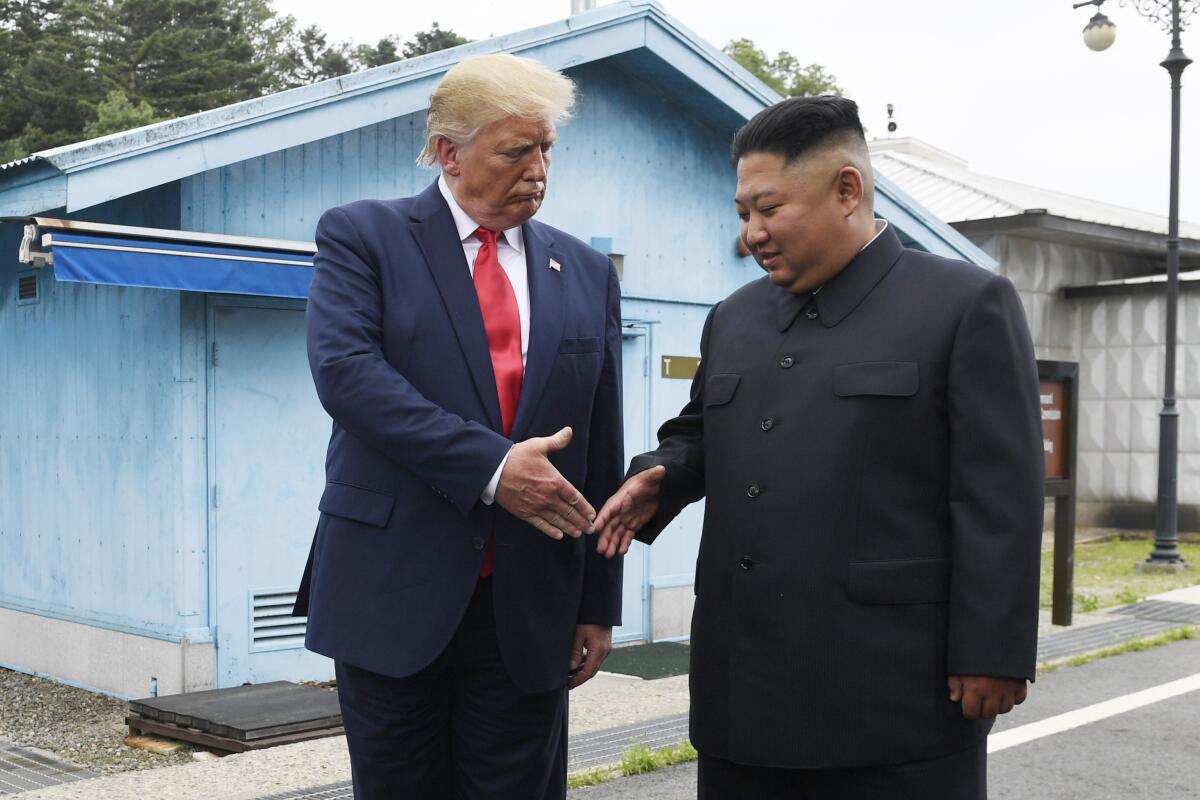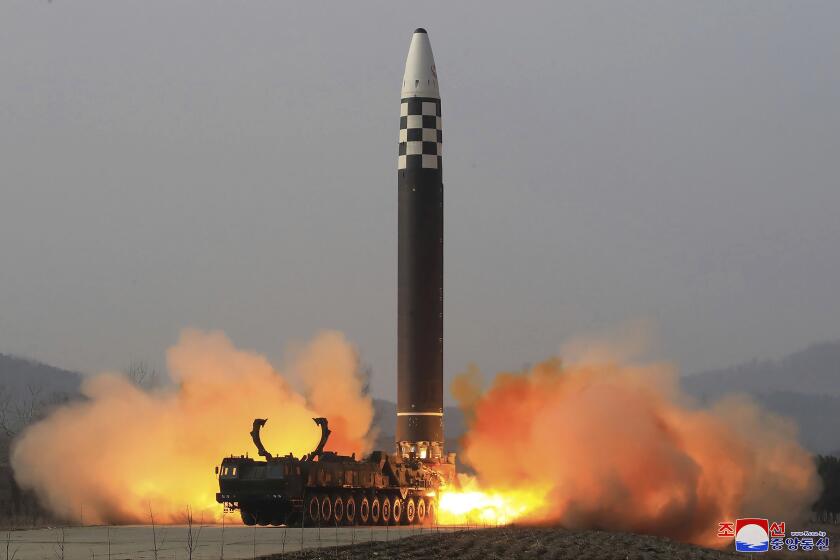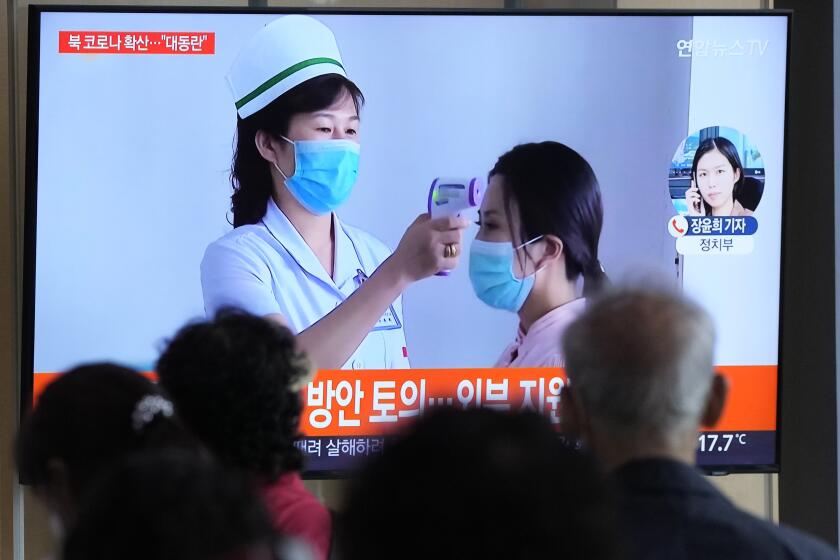News Analysis: New approach, same problem with North Korea: How to deal with Kim Jong Un

SEOUL â Former President Trumpâs relationship with North Korean leader Kim Jong Un featured the former reality-star president at his most theatrical: threats of âfire and fury,â followed by splashy meetings, a trip to the demilitarized border with South Korea and exchanges of âlove lettersâ with the authoritarian ruler.
Trumpâs efforts failed to slow North Koreaâs development of new nuclear weapons and missiles. President Biden has taken a lower-key approach in the hopes of persuading Kim to take a serious stab at diplomacy. That strategy that has not yet borne fruit, and U.S. officials are bracing for a possible nuclear test or another missile test by Pyongyang while Biden is in South Korea or Japan. Days before Biden arrived in Seoul, North Korea launched three short-range ballistic missiles into the sea.
âThere is a genuine possibility and real risk of some kind of provocation,â national security advisor Jake Sullivan said before Biden landed in Seoul on Friday.
He said U.S. officials have been in contact with South Korea, Japan and China to prepare for the possibility. âWe will respond to any threats and any aggression decisively,â he said.
Missile testing is a familiar play by North Korea for attention. Each test also allows North Korea to send a clear message that it is an imminent threat to its neighbors and U.S. interests. North Korea has been making steady progress on building a reliable long-range missile that can reach the U.S. mainland.
âYouâre really looking at a question of not if, but whenâ Pyongyang perfects a credible intercontinental ballistic missile, said Sheila A. Smith, an Asia specialist who wrote âJapan Rearmed: The Politics of Military Power.â
North Korea fired a suspected ballistic missile toward the sea, South Korea and Japan said, in the latest of a series of weapons demonstrations.
Experts in the region say there is little Biden can do to reengage Kim unless and until the North Korean ruler decides it is time.
U.S. officials say they have offered to restart talks aimed at ending Pyongyangâs nuclear program, proposing an approach that would let each side make mutual concessions to build trust. So far, Washington has been rebuffed.
âNorth Korea has not displayed any indication of willingness to engage in any meaningful or constructive diplomacy,â Sullivan said.
Getting North Korea to take diplomacy seriously has bedeviled the U.S. for decades. But there has been less urgency from both sides over the last two years.
Since the COVID-19 pandemic began in 2020, the isolated and impoverished country has become more isolated. As the coronavirus swept across the globe, Kim shut down his country, even cutting down trade with his countryâs most important neighbor, China.
This month, Kim acknowledged an outbreak of the disease for the first time, with 2 million cases reported this week.
âMost people assume theyâve had other cases, but Kim Jong Un would have been extremely paranoidâ about the pandemic regardless, said Susan Thornton, a retired diplomat who spent nearly three decades focusing on Asia. âThey basically retreated and sealed up the hermit kingdom.â
North Korea says it has confirmed 15 more deaths and hundreds of thousands of patients with fevers amid the countryâs first declared COVID outbreak.
Public health and security experts say they are concerned the poor country is struggling to handle a surge in infections, sparking a humanitarian crisis that could prompt Kim to seek more attention with his weapons program. His country has conducted more missile tests this year than in all of 2021, according to the Center for Strategic and International Studies.
Thornton and other experts suspect Kim has written off negotiations for the moment and is working on his next aggressive act of deterrence to show the U.S. that Pyongyang is continuing to flout a pledge in 2018 to suspend nuclear and long-range missile tests.
South Koreaâs new leader, Yoon Suk-yeol, is expected to take a harder line against Pyongyang than his predecessor, Moon Jae-in, who focused on crafting a peace treaty with North Korea and was willing to take bigger chances to get one.
Victor Cha, who led negotiations with North Korea in the George W. Bush administration, said at a briefing with reporters this week that he expects Yoon to assert South Koreaâs role as a regional power and global player, turning away from Moonâs âobsession with North Korea.â
Yoon and Biden are likely to demand more concessions from North Korea before agreeing to a formal peace treaty. Cha said North Koreaâs COVID crisis is the only issue that might bring immediate engagement, with an agreement from Yoon to provide vaccines and potential American help through intermediaries.
A senior Biden administration official said Saturday that âwe have a common interest in doing whatever we canâ to address the COVID outbreak in North Korea, working with âinternational communities through whatever mechanism is appropriate.â
Moon, South Koreaâs former leader, was instrumental in persuading Trump to meet with Kim. Trump agreed at the leadersâ first meeting in Singapore to suspend joint military exercises with South Korea, a move that surprised and concerned some military advisors, who wanted more in return.
Many experts, including Smith, gave Trump credit for trying but thought that he ultimately gave Kim too many meetings and that the administration failed to do the homework required to produce meaningful results.
Bidenâs secretary of State, Antony J. Blinken, was highly critical of Trumpâs approach in a 2020 interview with The Times in which he argued that the summits with the U.S. president gave Kim international legitimacy.
âItâs going to be a real heavy lift to get us back to a place where weâre actually advancing interests,â Blinken, then an advisor to Bidenâs campaign, warned in the interview.
That prediction appears to have been borne out.
More to Read
Get the L.A. Times Politics newsletter
Deeply reported insights into legislation, politics and policy from Sacramento, Washington and beyond. In your inbox three times per week.
You may occasionally receive promotional content from the Los Angeles Times.













